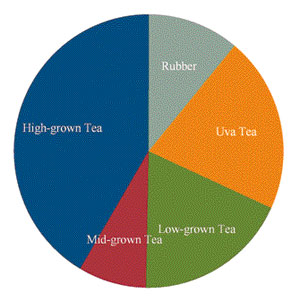Low grown tea, rubber enjoy profits
Ravi Ladduwahetty
A presentation titled: “ The
profitability and the productivity of Sri Lanka’s Plantations - Tea and
Rubber Sectors and implications for wage determination” was delivered by
Dr Ramani Gunatilleke at the Sri Lanka Tea Board auditorium last
Tuesday. This was during the news conference held by the Planters
Association that day.
Dr Gunatilleke is a Consultant to the
World Bank, ILO and ADB.
The context of the presentation was Sri Lanka’s share of the global
market in commodities steadily declining which is generally attributed
to high costs of production and low levels of productivity compared to
competitors.
The growing importance of smallholders in the production of green
leaf, especially in the low country, reflects the different cost
structures they face relative to the Regional Plantation Companies (RPCs).

The RPCs are challenged to be more competitive.
She said that the objectives of the study has been to inform the wage
negotiation process, initiate a stock-take to inform the process of
developing long-term strategies for the sector as a whole, by the
Regional Plantation Companies themselves.
Another objective of the study was to provide stakeholders, including
policy-makers, with a rigorous and independent assessment of the
profitability and sustainability of the RPC sector.
Costs of production
One of the burning issues was the high costs of production vis a vis
the low levels of productivity compared to competitors.
The growing importance of smallholders in the production of green
leaf, especially in the low country, reflects the different cost
structures that they face relative to the Regional Plantation Companies
(RPCs).
The RPCs are challenged to be more competitive and Sri Lanka’s share
of the global market in commodities has been steadily declining, has
also been a bone of contention.
Profitability
According to the study done by Dr Gunatilleke, only low grown tea and
rubber have been enjoying profits in the recent past. The high grown,
mid grown and Uva tea sectors have been posting losses, but the losses
have been stable rather than increasing over the years.
Impact of exchange rate movements on profitability was an important
issue which merits careful analysis which is beyond the scope of the
present paper, she said.
Productivity
She also noted that labour productivity had been stable in all the
sectors and so have yields other than in low grown tea where yields have
been declining.
Scatter plots of pooled real profits and productivity data of RPCs
for the fifteen years of the reference period, strongly suggest that
profitability is positively associated with labour productivity in all
five sectors.
The results suggest that increasing productivity is fundamental to
increasing profitability in the RPC sector.
Losses experienced by the high grown, mid-grown, and Uva sectors were
due to the sectors’ inability to increase productivity sufficiently to
offset high costs relative to those of competitors.
Costs
Results suggest that profitability of the low grown sector lie in the
processing of bought leaf rather than estate production as neither
labour productivity nor yields have increased. Tea is a labour-intensive
industry, so labour accounts for bulk of production costs.
Labour costs including welfare amount to 46 percent of Nett Sale
Average in High Growns, 18 percent in Low Growns if total NSA was taken
into account but 31 percent if attributed NSA is taken into account
(difference due to the bought leaf component).
“With provisioning for gratuity, labour costs accounted for between
43 to 54 per cent of the NSA in the high grown, mid-grown, Uva and
rubber sectors in 2009,” she said.
Low grown has reported a much lower rate of 21 per cent because of
the bought leaf component. Long-term share of labour costs in NSA
appears relatively stable in all the sectors except rubber.
Management’s and materials’ shares of Net Sale Averages in the Mid
Grown sector have not been stable and materials costs in the Low Grown
sector have also not reverted to mean in the long-term
Graphical analysis of the share of compensation to labour in value
added: High Grown risen slightly, Mid Grown stable, Uva largely stable,
Low Grown declined, rose until 2001, declined until 2006, rose again
after that.
Productivity
Labour productivity has been stable in all the sectors and so have
yields other than in low grown tea where yields have been declining, she
said. Scatter plots of pooled real profits and productivity data of RPCs
for the fifteen years of the reference period, strongly suggest that
profitability is positively associated with labour productivity in all
five sectors.
The results suggest that increasing productivity is fundamental to
increasing profitability in the RPC sector. Losses experienced by the
high grown, mid-grown, and Uva sectors are due to the sectors’ inability
to increase productivity sufficiently to offset high costs relative to
those of competitors.
Results suggest that profitability of the low grown sector lies in
the processing of bought leaf rather than estate production as neither
labour productivity nor yields have increased.
Policy issues
Some of the policy issues, she said, range from:
*Should land productivity be increased through replanting, should
diversification into more productive activities, or both? Would
processing rather than green leaf production make more economic sense?
* How sustainable is the present system of a RPC sector-wide wage
determined through a model of centralized wage bargaining?
* Since there is such diversity in the sector, a one-size-fits-all
approach to wage bargaining appears not to be the most appropriate for
the sector.
* Uniform wage rate has only succeeded in moving workers out of the
industry as a whole, while making labour immobile within the industry
itself.
* Privatization of the management of the plantations appears not to
have entailed a sufficiently positive paradigm shift in the sector’s
orientation towards the market. |



